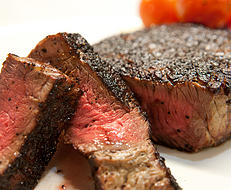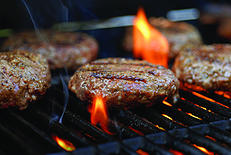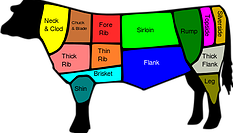Belted Galloway
“You are what you eat”
-
VACCINE FREE
-
HORMONE FREE
-
ANTIBOTIC FREE
-
GRASS-FED, NO GRAIN, NO ANIMAL PROTEIN
What would your health be like if you stayed in a cubical all day in a dark, stuffy office, eating fast food, and under high amounts of stress? Odds are you would not be in the best of health. Why would animals be any different? Most cattle today are raised in feedlots. Feedlots are farms where a large number of cattle are kept, usually on concrete, in a small area and fed a high grain diet. The lifestyle is great for growing large fat cows, but it is not good for their health. These animals are likely to have high cholesterol, enlarged livers, and an increased risk of infections or disease. However, cattle raised on open pasture land with room to walk and fresh grass to eat are more likely to have healthy cholesterol levels, fat percentages, and no signs of disease or infection.
Health Benefits
The first thing people notice about the meat is the fat has a more yellow tint . This is a sign of a higher beta-carotene count. Beta-carotene is used to make vitamin A which is a powerful antioxidant and helps protect cells from free-radicals. Grass-fed beef has four to six times’ lower fat than grain-fed beef. It also has half the saturated fat, making it as lean as poultry and wild game. In turn, it has a much lower calorie count. In the Standard American Diet there are too few Omega 3’s to Omega 6’s. This is often related to inflammatory diseases such as RA, fibromyalgia, etc. Grass-fed beef is three times’ higher in omega 3 than grain-fed and is in balance to what the body needs for the Omega’s 3 and 6 ratio. Grass-fed beef also has four times more Vitamin E. Vitamin E helps form red blood cells, powerful antioxidants that protect cell membrane and other fat-soluble body tissues. Grass-fed beef also has five times more conjugated linoleic acid (CLA) which can prevent and even reduce cancer-cell growth.
Our herd is a small, but growing herd of Belted Galloway beef. They are raised on over 500 acres of family land in Red River County (NE Texas). They are constantly grazing in the pasture, which includes a mix of several native grasses. To ensure they are receiving their trace mineral and salt we supplement with organic kelp and sea salt. Organic kelp also adds flavor to the meat and is a natural tenderizer. For a natural de-wormer, anti-parasitic Diatomaceous Earth is added to their supplements.
The animal is sold directly to the individual. The cow can be split between people in halves and quarters as well. An average cow weights approx 1000 lbs before harvesting. The cows are sold for a certain price per pound. There is a total of approximately 40% body mass loss after harvest and a 2 weeks aging process at the meat locker. We are able to take the animal to the meat market for processing for you, but processing costs are your responsibility. Previous to harvesting the paperwork can be brought to you that allows you to choose certain cuts of meat and packaging preferences. A deep freeze is best for storage and the beef stores easily for 12-16 months. On average a whole cow can feed a family of four for approximately 1 year. Harvest times are in May and October of each year.




© by Moore Chiropractic
